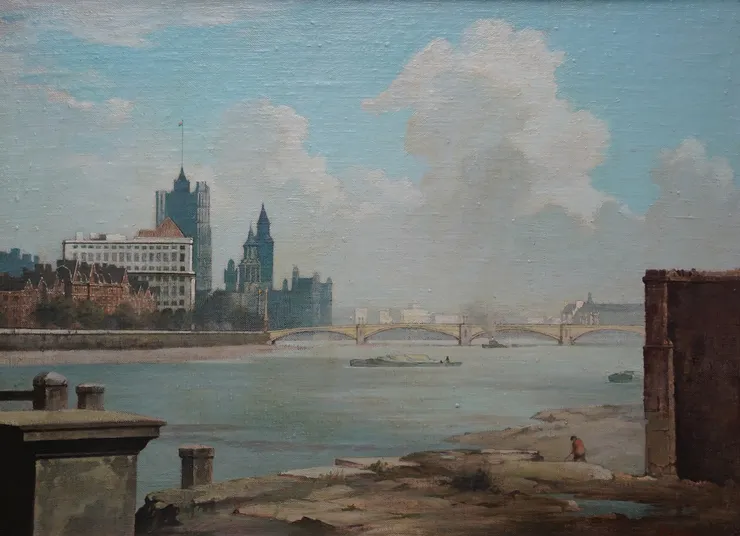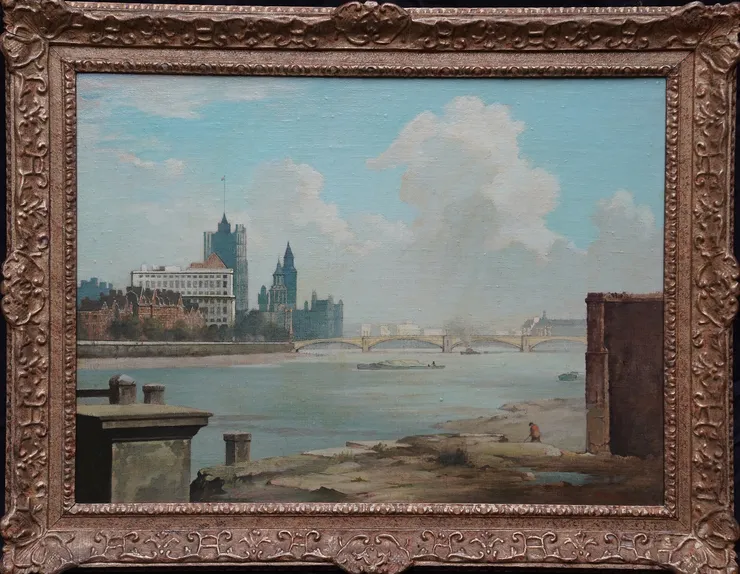Bertram Nicholls (1883-1974)
| Artist Name | Bertram Nicholls (1883-1974) |
|---|---|
| Title | View from Vauxhall Bridge, London 1951 |
| Description | This superb Post Impressionist London landscape oil painting is by noted Slade School trained artist Bertram Nicholls. Painted in 1951 and with excellent provenance, the location is Vauxhall Bridge, a Grade II listed steel and granite deck arch bridge in central London. It crosses the River Thames in a southeast–northwest direction between Vauxhall on the south bank and Pimlico on the north bank. Opened in 1906, it replaced an earlier bridge, originally known as Regent Bridge but later renamed Vauxhall Bridge, built between 1809 and 1816 as part of a scheme for redeveloping the south bank of the Thames. The bridge was built at a location in the river previously served by a ferry. This is stunning Post Impressionist 1950's oil painting of the Thames and Vauxhall Bridge and surroundings with great brushwork and style and is an excellent example of Nicholls' work. Signed lower right. |
| Provenance | The Fine Art Society, New Bond Street, London; Private collection, UK. |
| Medium | Oil on Canvas |
| Size | 30 x 22 inches |
| Frame | Housed in a gilt frame, 37 inches by 29 inches, in good condition. |
| Condition | Good condition. |
| Biography | Bertram Nicholls (1883–1974). Landscape painter, especially in oil, whose pictures owe much, according to his biographer Frank Rutter, to “diligent study of our own eighteenth-century masters”, having an old-fashioned stillness and high degree of finish. Born in Didsbury, Manchester, Nicholls studied at the Slade School of Fine Art, 1901–4, although he said that it took him some years to unlearn much of what he had been taught there. In 1904 went to Madrid and devoted several months to study of Velasquez, and on his return studied with Fred W Jackson in Yorkshire. Disillusioned with modern art ideas in London, went to Montreuil in 1911 where he met his wife who introduced him to Frank Mura, who painted in Sussex where Nicholls settled, and who “initiated him into the secrets of finer craftsmanship” of the earlier Dutch painters. First exhibited at RA in 1912, afterwards regularly. During World War I was enrolled in Kite Balloon Service of Royal Flying Corps and made panoramic drawings in France. After the war made extensive research into methods used by Sir Joshua Reynolds and technique of Richard Wilson. His painting Drying the Sails was bought by Tate Gallery in 1921, his first public recognition. Nicholls exhibited widely in Britain and abroad, having first one-man show at Barbizon House in 1924. Work in many public galleries. Was president of MAFA, 1921–31 and of RBA, 1931–47. Lived at Steyning, Sussex, and died in Worthing. Artists in Britain Since 1945 by David Buckman THE YARN MARKET, DUNSTER Somerset, England was built in the early 17th century.It is an octagonal building constructed around a central pier. The tiled roof provides shelter from the rain. It has been designated as a Grade I listed building and scheduled monument. Dunster was an important market place in the Middle Ages particularly following the construction of Dunster Castle and the establishment of the Priory Church of St George. Dunster had become a centre for woollen and clothing production by the 13th century, with the market dating back to at least 1222, and a particular kind of kersey or broadcloth became known as 'Dunsters'. Dunster Castle stands on a site which has been fortified since the late Anglo-Saxon period, signifying the importance of the area. After the Norman conquest of England in the 11th century, William de Mohun constructed a timber castle on the site as part of the pacification of Somerset. A stone shell keep was built on the motte by the start of the 12th century, and the castle survived a siege during the early years of the Anarchy. At the end of the 14th century the de Mohuns sold the castle to the Luttrell family. By the 15th century the importance of the town was declining particularly due to the silting up of the harbour.[3] The Luttrells wanted to maintain the town's importance as a market, and in 1609 George Luttrell, of the Luttrell family constructed the market to shelter traders and their wares from the rain and provide more security for their wares. The exact date of construction is debated and a variety of dates are given in different sources, however 1609 is considered the most likely |
| Price | £4500 |

